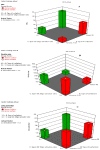Formulation of Chitosan-Coated Brigatinib Nanospanlastics: Optimization, Characterization, Stability Assessment and In-Vitro Cytotoxicity Activity against H-1975 Cell Lines
- PMID: 35337145
- PMCID: PMC8948618
- DOI: 10.3390/ph15030348
Formulation of Chitosan-Coated Brigatinib Nanospanlastics: Optimization, Characterization, Stability Assessment and In-Vitro Cytotoxicity Activity against H-1975 Cell Lines
Abstract
The purpose of the current study was to develop Brigatinib (BGT)-loaded nanospanlastics (BGT-loaded NSPs) (S1-S13) containing Span 60 with different edge activators (Tween 80 and Pluronic F127) and optimized based on the vesicle size, zeta potential (ZP), and percent entrapment efficiency (%EE) using Design-Expert® software. The optimum formula was recommended with desirability of 0.819 and composed of Span-60:Tween 80 at a ratio of 4:1 and 10 min as a sonication time (S13). It showed predicted EE% (81.58%), vesicle size (386.55 nm), and ZP (-29.51 mv). The optimized nanospanlastics (S13) was further coated with chitosan and further evaluated for Differential Scanning Calorimetry (DSC), X-ray Diffraction (XRD), in vitro release, Transmission Electron Microscopy (TEM), stability and in-vitro cytotoxicity studies against H-1975 lung cancer cell lines. The DSC and XRD revealed complete encapsulation of the drug. TEM imagery revealed spherical nanovesicles with a smooth surface. Also, the coated formula showed high stability for three months in two different conditions. Moreover, it resulted in improved and sustained drug release than free BGT suspension and exhibited Higuchi kinetic release mechanism. The cytotoxic activity of BGT-loaded SPs (S13) was enhanced three times in comparison to free the BGT drug against the H-1975 cell lines. Overall, these results confirmed that BGT-loaded SPs could be a promising nanocarrier to improve the anticancer efficacy of BGT.
Keywords: brigatinib; chitosan; cytotoxicity; nanospanlastics; optimization; sustained release.
Conflict of interest statement
The authors declare no conflict of interest.
Figures










Similar articles
-
Box Behnken optimization of cubosomes for enhancing the anticancer activity of metformin: Design, characterization, and in-vitro cell proliferation assay on MDA-MB-231 breast and LOVO colon cancer cell lines.Int J Pharm X. 2023 Aug 25;6:100208. doi: 10.1016/j.ijpx.2023.100208. eCollection 2023 Dec 15. Int J Pharm X. 2023. PMID: 37680878 Free PMC article.
-
Formulation of Nanospanlastics as a Promising Approach for Improving the Topical Delivery of a Natural Leukotriene Inhibitor (3-Acetyl-11-Keto-β-Boswellic Acid): Statistical Optimization, in vitro Characterization, and ex vivo Permeation Study.Drug Des Devel Ther. 2020 Sep 15;14:3697-3721. doi: 10.2147/DDDT.S265167. eCollection 2020. Drug Des Devel Ther. 2020. PMID: 32982176 Free PMC article.
-
Wound Healing Efficacy of Rosuvastatin Transethosomal Gel, I Optimal Optimization, Histological and In Vivo Evaluation.Pharmaceutics. 2022 Nov 19;14(11):2521. doi: 10.3390/pharmaceutics14112521. Pharmaceutics. 2022. PMID: 36432712 Free PMC article.
-
Response Surface Optimization, Fabrication and In-vitro Investigation of Elastic Nanovesicles Loaded with Flunarizine.Pharm Nanotechnol. 2025 Apr 18. doi: 10.2174/0122117385392040250404114249. Online ahead of print. Pharm Nanotechnol. 2025. PMID: 40257018
-
Formulation optimization of etoposide loaded PLGA nanoparticles by double factorial design and their evaluation.Curr Drug Deliv. 2010 Jan;7(1):51-64. doi: 10.2174/156720110790396517. Curr Drug Deliv. 2010. PMID: 20044908 Review.
Cited by
-
Ocular mucoadhesive and biodegradable spanlastics loaded cationic spongy insert for enhancing and sustaining the anti-inflammatory effect of prednisolone Na phosphate; Preparation, I-optimal optimization, and In-vivo evaluation.Int J Pharm X. 2024 Oct 16;8:100293. doi: 10.1016/j.ijpx.2024.100293. eCollection 2024 Dec. Int J Pharm X. 2024. PMID: 39498272 Free PMC article.
-
Fabrication of nanostructured lipid carriers ocugel for enhancing Loratadine used in treatment of COVID-19 related symptoms: statistical optimization, in-vitro, ex-vivo, and in-vivo studies evaluation.Drug Deliv. 2022 Dec;29(1):2868-2882. doi: 10.1080/10717544.2022.2115164. Drug Deliv. 2022. PMID: 36065090 Free PMC article.
-
Box Behnken optimization of cubosomes for enhancing the anticancer activity of metformin: Design, characterization, and in-vitro cell proliferation assay on MDA-MB-231 breast and LOVO colon cancer cell lines.Int J Pharm X. 2023 Aug 25;6:100208. doi: 10.1016/j.ijpx.2023.100208. eCollection 2023 Dec 15. Int J Pharm X. 2023. PMID: 37680878 Free PMC article.
-
Development and Characterization of In Situ Gelling Nasal Cilostazol Spanlastics.Gels. 2025 Jan 22;11(2):82. doi: 10.3390/gels11020082. Gels. 2025. PMID: 39996625 Free PMC article.
-
Fabrication and Assessment of Orodispersible Tablets Loaded with Cubosomes for the Improved Anticancer Activity of Simvastatin against the MDA-MB-231 Breast Cancer Cell Line.Polymers (Basel). 2023 Apr 2;15(7):1774. doi: 10.3390/polym15071774. Polymers (Basel). 2023. PMID: 37050387 Free PMC article.
References
-
- Kim D.W., Tiseo M., Ahn M.J., Reckamp K.L., Hansen K.H., Kim S.W., Leighl N.B. Brigatinib in patients with crizotinib-refractory anaplastic lymphoma kinase-positive non-small-cell lung cancer: A randomized, multicenter phase II trial. J. Clin. Oncol. 2017;35:2490–2498. doi: 10.1200/JCO.2016.71.5904. - DOI - PubMed
Grants and funding
LinkOut - more resources
Full Text Sources

